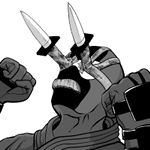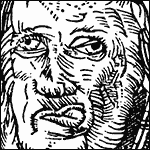|
Do any of you use eSun PLA Pro and find that the ideal temperature is way higher than you expect? It seems to want to run at 225ish for me, and Hatchbox and Prusa PLAs run closer to 205.
|
|
|
|

|
| # ? Jun 11, 2024 17:03 |
|
NeurosisHead posted:Do any of you use eSun PLA Pro and find that the ideal temperature is way higher than you expect? It seems to want to run at 225ish for me, and Hatchbox and Prusa PLAs run closer to 205. You mean PLA+? It does say 205-225 °C on their website.
|
|
|
|
PlaneGuy posted:kit version of printrbelt looks pretty dope That is for chumps. Get the Blackbelt printer. https://twitter.com/blackbelt3d
|
|
|
|
NeurosisHead posted:Do any of you use eSun PLA Pro and find that the ideal temperature is way higher than you expect? It seems to want to run at 225ish for me, and Hatchbox and Prusa PLAs run closer to 205. Yes, best filament I use. Hatchbox is 205, PLA Pro is 215 for me. Also their firetruck red is the best red.
|
|
|
|
ClassH posted:Yes, best filament I use. Hatchbox is 205, PLA Pro is 215 for me. That's the one I got, and I love it! BMan posted:You mean PLA+? It does say 205-225 °C on their website. I do, yeah. I've found (in my very limited experience) that manufactures seem to recommend higher temps than what actual calibration shows me works best. I was kind of surprised to see it actually be true though.
|
|
|
|
Acid Reflux posted:If you ever want to use Cura again, try these travel settings to avoid that same problem: On Slic3r, has anyone had and fixed bonding issues between infill and walls? I'm noticing it around circles especially. Stuff like screw holes are particularly bad. They just aren't bonding fully even with the infill/wall overlap set to 23%. Straight walls are usually fine.
|
|
|
|
Uh, okay I think I just figured it out. For the infill overlap Slic3r wants you to specify a mm amount or %. I didn't think to put in the % sign. After doing so the path preview immediately updated closer, which it hadn't been doing before.
|
|
|
|
... I have literally no idea where else to post this so here it goes. I want to find out if there's any good way to do a, for lack of a better term, un-slicer. Like, I do car stuff. I want to take a cylinder head (aluminum casting with all sorts of important internal features if you're not familiar) and dunk it in paint so all the air-exposed surfaces are black, then put it on a milling machine, take 1mm thick cuts and put a flatbed scanner against it - so the bits that are exposed at each layer will be nice and contrasty against the black. I know I could take a series of slices like that and reconstruct a model in Solidworks from that, but is there any conceivable way to hook into slicer development to go the other way?
|
|
|
|
mekilljoydammit posted:... I have literally no idea where else to post this so here it goes. Nope. You'll need some software to convert the images into voxel data and then convert that into a mesh with "marching cubes" or a similar algorithm. This software definitely exists but I have no idea what it is, sorry! edit: Maybe MeshLab does it? BMan fucked around with this message at 02:56 on May 16, 2018 |
|
|
|
Yep, putting in the % sign did the job!
|
|
|
|
BMan posted:Wrong, nylon is far more vulnerable to warping (unless you buy Taulman's special expensive blends, I guess) Alloy910 isn't cheap, but there's no warping and can be printed on a cold bed. You have to print it slower, but it's insanely tough. The biggest issue was that it was hard to glue, but JB Weld Plastic Bonder will stick to it and it's an easy glue to work with. I use PLA for prototypes and Alloy910 for final parts.
|
|
|
|
mekilljoydammit posted:... I have literally no idea where else to post this so here it goes. While I've never used it, it looks like ImageJ can do this. How I first found it. More info, and someone suggesting a different plugin if the images were too complex This one looks particularly useful. They mostly talk about tiff files, but it looks like imagej should(?) be able to handle most input. Even if it doesn't, there are many programs out there that can batch convert between different formats. It doesn't look friendly, but I think it should be able to do what you want automatically. Otherwise, look up terms like sectioning reconstruction, tomography reconstruction, and z-stack. There's several other programs that can do this, and there's piles of matlab and python code out there from people who have rolled their own.
|
|
|
|
mekilljoydammit posted:... I have literally no idea where else to post this so here it goes. How precise do you need the geometry? Some cad programs let you import an image to draw on or reference off, you could import all of your images and place them 1mm apart then draw the part using the images as reference points.
|
|
|
|
Aurium posted:While I've never used it, it looks like ImageJ can do this. Awesome, that looks like a good resource for things to try. I'd forgotten about CT scans and how they'd be doing the same sort of thing. cakesmith handyman posted:How precise do you need the geometry? Some cad programs let you import an image to draw on or reference off, you could import all of your images and place them 1mm apart then draw the part using the images as reference points. In an ideal world "perfectly" precise... in the real world, I'm reverse engineering sand castings, so by their nature the original parts aren't going to be piece-to-piece repeatable on non-machined surfaces, and I anticipate having to do some fiddling to get the machined points right. Using the images as reference images is my plan B - I've done it before and it's cumbersome to say the least.
|
|
|
|
mekilljoydammit posted:Awesome, that looks like a good resource for things to try. I'd forgotten about CT scans and how they'd be doing the same sort of thing. https://www.youtube.com/watch?v=hF3V-GHiJ78
|
|
|
|
Parts Kit posted:Here's one DIY CT scanner that lists some of the software used in the description. No idea if it will really help or not but might be a good start? The people that make benchy made a photo studio which is like about but has a smart phone mount, a center point with a mod you can print to let you rotate it with a crank , mount to let you use paper to act as a back drop and mini pen light holders to act as lighting. Use a 3d model scanner (like Adobe has one) for the smart phone that requires you to rotate the object to create a model. What you should also do, since you are willing to paint it, is to paint it Black but then just glob on paint splatters randomly so the scanner can create a more accurate model
|
|
|
|
Parts Kit posted:Here's one DIY CT scanner that lists some of the software used in the description. No idea if it will really help or not but might be a good start?  I shouldn't be surprised that someone made a DIY CT scanner but... noooooope nope nope nope nope. That said, I now have a lot of good places to look for software to do what I want, thanks all. EVIL Gibson posted:Use a 3d model scanner (like Adobe has one) for the smart phone that requires you to rotate the object to create a model. I'm working on point cloud scanning for other purposes... the problem for this specific purpose is that most of the interesting stuff is internal features that aren't visible.
|
|
|
|
mekilljoydammit posted:
Oh. God speed on that. poo poo... That sucks.
|
|
|
|
My stupid plan to build a cr-10 adjacent hypercube is slowly coming together. I assembled the X-gantry and nearly finished the Z-motion system.  I need to cut down the v-slot 2040 profile and then my z axis will be sorted.  I'm just waiting on my steel smoothrods and then I can just have a couple late nights and finish it off Jestery fucked around with this message at 23:28 on May 16, 2018 |
|
|
|
mekilljoydammit posted:... I have literally no idea where else to post this so here it goes. I think this would be much more applicable than a CT scanner analogy which is projection entirely through an object. http://www.instructables.com/id/Milkscanner-V1.0/ And while searching for that I stumbled across this which looks like a more modern variation. Might have better code/process (I haven't looked too closely at either projects really): http://www.instructables.com/id/GotMesh-the-Most-Cheap-and-Simplistic-3D-Scanner/
|
|
|
|
peepsalot posted:About a decade ago there was a project called milk scanner which took images of an object being submerged in milk (or whatever opaque liquid) one layer at a time and then reconstruct the model from the layer images. The last is perfect in every way because you're right that the scanner analogy is more comparable, and it also happens to be done in Python, which out of all programming languages I know, I am least bad at. Thank you! Guess this means I have to *do* it now. 
|
|
|
|
mewse posted:I'd say it's a pretty good chance the fan header you're connected to is for the part cooling fan. Whatever slicer you're using is setting the part cooling fan to zero for the first few layers. M106 with no fan index refers to the part cooling fan. Ah-ha, that was the problem. Thank you! Swapped the wiring and the hot end fan runs all the time (which makes more sense) and the parts fan kicked on after a minute or so of printing. Cheers!
|
|
|
|
I'm really enjoying the sense of discovery that comes with getting into this hobby. Every time something doesn't work right and I figure what variable to fiddle with and which way to move it I feel like a smart and special boy and it's great. Like yeah, sure, I just dropped the temp and increased retraction which was made sense to do, but look! I have real, tangible results from my actions and this print is better than the last one!
|
|
|
|
NeurosisHead posted:I'm really enjoying the sense of discovery that comes with getting into this hobby. Every time something doesn't work right and I figure what variable to fiddle with and which way to move it I feel like a smart and special boy and it's great. Like yeah, sure, I just dropped the temp and increased retraction which was made sense to do, but look! I have real, tangible results from my actions and this print is better than the last one! Whenever I read posts like this I feel like I'm missing out because the only time a print fails on my 3d printer is when there is a tangle in the spool or I'm using out-of-spec filament. 
|
|
|
|
I'm sure most people don't keep up with the changes going into Slic3r Prusa Edition but Prusa now employs six full-time developers to work on it as well as a dedicated QA person so there's always something new coming or being fixed. If nobody minds I'll post about noticeable things in releases. Three weeks ago now the last release created a new iteration of speed-cooling logic. If you've ever tried to print a pyramid or step cube without cooling, you know that as the layer time gets really small close to the top, the plastic doesn't have enough time to fully harden before the next layer comes in which leads to the nozzle pushing around molten plastic and the tip becoming a mushy soft serve ice cream top. Slicers can generally adjust the output of a cooling fan higher the quicker the layer is printed to help compensate. When this isn't enough, they can slow down printing. This solution has evolved over time:
For example if you're printing external perimeters at 60mm/s, internal at 70mm/s and infill at 80mm/s, first Slic3r will slow down the infill from 80 to 70mm/s (or any amount in between). If that's not enough, it will then slow down the infill and the internal perimeters from 70 to 60mms/s. If we're still too quick, everything will be scaled down below 60mm/s until the minimum layer time is reached or minimum speed is hit. This gives the system a lot more moves to slow the print over which means less slowdown overall, but more importantly the nozzle pressure is more consistently maintained instead of switching quickly between very fast and very slow extrusion. And Slic3r 1.40 coming soon! While I am here let me ask, has anyone come across some sort of open-collector PWM to analog voltage power board? I would love to convert my part cooling fan from 12V PWM output we all have with RAMPS / Smoothieboard / Duet into a smooth 0V-12V output. I could design a buck converter + op amp board that essentially becomes a digitally controllable step down but I would imagine this would be something other people would desire as well but can't find them on eBay. My parts fan makes the worst whiny noise at lower speeds when driven via PWM but is perfectly cromulent when driven with pure voltage.
|
|
|
|
CapnBry posted:
I'm not an electronics expert, but could you do this with just a capacitor filter?
|
|
|
|
Sufficient capacitance should smooth it. Why do you want analog control? Typically PWM is used because your instantaneous power delivery is more predictable and is easier to control. What is analog DC going to give you? E: I can't read. As pointed out, a higher PWM frequently helps with noises. Above 20kHz should cause any whine to be out of human hearing range. carticket fucked around with this message at 17:33 on May 18, 2018 |
|
|
|
|
What firmware? In Marlin, there are a couple of variables you can change in configuration.h that affect the fan PWM frequency, or switch from hardware to software PWM. code:
|
|
|
|
I just started a print on the MP Select Mini for all of the sections of an SR-71 Blackbird model at once using a .0875 layer height. It's been running all day so far and has the base of each part down well and is on layer 28 of 1,020. Octoprint claims it'll be done printing by Monday morning. Weeee!
|
|
|
|
biracial bear for uncut posted:I just started a print on the MP Select Mini for all of the sections of an SR-71 Blackbird model at once using a .0875 layer height. Good luck!
|
|
|
|
Acid Reflux posted:What firmware? In Marlin, there are a couple of variables you can change in configuration.h that affect the fan PWM frequency, or switch from hardware to software PWM. With capacitance you have a near infinite inrush current supplied by a 12V 30A DC power supply. Sure, the MOSFET and wiring/traces add some resistance but that is orders of magnitude lower than the current that can be supplied. To find the right output capacitance you can pick a ripple voltage and then given the exact current the fan pulls at your desired voltage you can reverse the capacitance. But if you change the load (say while printing a different section that needs more or less blower) you need different capacitance. Too much and the blower will run at full speed all the time as the input can fill the cap faster than the blower can take it away, and too low a capacitance and it does nothing at all. In short, finding an ideal capacitor to run at a fixed load is trivial but if you want to vary the load you've got a really non-linear response. It is like you have a garden hose (the 12V in) filling a bucket (a capacitor) and a small tube siphoning out the liquid (the fan load). What size bucket will always remain filled to the same amount regardless of how fast the siphon is sucking it out? No matter the size of the bucket, it will either fill or empty depending on the amount coming in vs going out unless perfectly balanced at a fixed set of values (bucket size, inrush amount, depletion amount). Changing the PWM frequency changes the capacitor needed and can change the sound caused by the PWM switching, but we're not driving a brushed DC motor here. There's plenty more noise made by the fan controller integrated into the fan's hub which is expecting continuous voltage and switching the coils on its own. The PWM switching frequency can be selected in such a way that the harmonics induced at a second order by the PWM turning off and on the fan controller but again this would be very specific to that fan at that rotational speed. I just figured in this age I can buy a "micro buck converter" from eBay at 50 cents each, there has to exist something that instead of having a potentiometer on it to adjust the output it would have a PWM input to adjust the output voltage. Especially considering the millions of arduino projects where people might want a software adjustable voltage supply, it seems strange to not have this part out there. You can buy FET boxes that will boost PWM current, and you can buy digitally controllable buck converters (which use an STM32 and a 7-segment display / buttons for input) but nothing that just takes a 100Hz-1KHz PWM and digitally adjusts the voltage by the duty cycle. I figure it must exist, I just don't know what to search for to find it and making my own would cost like $5 a board. CapnBry fucked around with this message at 18:06 on May 18, 2018 |
|
|
|
biracial bear for uncut posted:I just started a print on the MP Select Mini for all of the sections of an SR-71 Blackbird model at once using a .0875 layer height.  Nice, definitely post pictures.
|
|
|
CapnBry posted:Changing the PWM frequency changes the capacitor needed and can change the sound caused by the PWM switching, but we're not driving a brushed DC motor here. There's plenty more noise made by the fan controller integrated into the fan's hub which is expecting continuous voltage and switching the coils on its own. This is a very fancy fan.
|
|
|
|
|
Mr. Powers posted:This is a very fancy fan. This is what any PC fan does.
|
|
|
insta posted:This is what any PC fan does. Most PC fans are brushless DC motors with a motor controller in them? E: apparently PC fans have gotten quite a bit fancier than when I last cared about what fans I had in my PC. In that case, my suggestion is to just replace the fan with a four pinner that expects a PWM input. carticket fucked around with this message at 21:44 on May 18, 2018 |
|
|
|
|
Parts Kit posted:
It's this thing: https://www.thingiverse.com/thing:2381619 Scaled to fit in the build plate area for everything but the stand (and a couple extra pins for the assembly). I'll scale the stand by the same amount and print it later. Current progress  And Octoprint Status screen:  Updated estimate says Sunday the 20th. Oh well, I'll come in Monday to a finished print, hopefully.
|
|
|
|
biracial bear for uncut posted:Crrent progress
|
|
|
|
CapnBry posted:While I am here let me ask, has anyone come across some sort of open-collector PWM to analog voltage power board? I would love to convert my part cooling fan from 12V PWM output we all have with RAMPS / Smoothieboard / Duet into a smooth 0V-12V output. I could design a buck converter + op amp board that essentially becomes a digitally controllable step down but I would imagine this would be something other people would desire as well but can't find them on eBay. My parts fan makes the worst whiny noise at lower speeds when driven via PWM but is perfectly cromulent when driven with pure voltage. Closest I've found is the femtobuck, which is a pwm controlled constant current source, which given that your load would be consistent you could make work. It's around $8, so not exactly super cheap. I think what I'd do is take one of the cheap buck regulators, and connect your pwm to the wiper connection. You might have to bias it a bit to give your self the proper range, but you have a convenient potentiometer right there.
|
|
|
|
Parts Kit posted:How do you like those spool rollers? Was thinking about making some myself. They function, but I didn't see any benefit over the stock holder. Figure I'll use them for oddball spools if I ever need too.
|
|
|
|

|
| # ? Jun 11, 2024 17:03 |
|
After almost a year and a half, I believe I've just realized that I made a mistake in assembling my printer. Last weekend I printed a cover for my LCD board. It's the first time I've printed something at this kind of size, as far as the X and Y axis were concerned. It's the first time I see that my 'squareness' is wrong. Instead of a rectangle, it came out as a slight rhombus. While troubleshooting this, I notice that my hot bed is not quite even with the front extrusion rod. I caught this early on this week, and ignored it, thinking it didn't mean anything. It wasn't until late last night when I realized it meant everything. Here's hoping my fix resolves this.
|
|
|



























